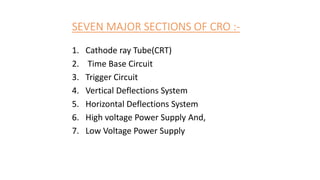Presentation CRO.pptx
- 1. A PRESENTATION ON CRO (Cathode Ray Oscilloscope) Sr.No. Name of students Roll No. 1 Krishna T. Korankar 21EE132 2 Ishwar S. Gurnule 21EE125
- 2. INDEX :- ? Oscilloscope ? Types Of Oscilloscope ? Working Of Oscilloscope ? Cathode ray Tubes The interior of a cathode- ray tube for use in an oscilloscope ? A Tektronix model 475A portable analog oscilloscope ? Use & Advantages
- 3. WHAT IS OSCILLOSCOPE :- ? An oscilloscope is a laboratory instrument commonly used to display and analyze the waveform of electronic signals. In effect, the device draws a graph of the instantaneous signal voltage as a function of time.
- 4. TYPES OF OSCILLOSCOPE :- ? Dual Beam ? Analogue Storage ? Digital Oscilloscope ? Digital Storage ? Digital Snapping ? Digital Phosphor ? PC Based ? Mixed
- 5. CATHOD RAY OSCILLOSCOPE :- ? A cathode ray oscilloscope is a very important electronic measuring Instrument. ? It is used to display and measure electrical signals, Time intervals and phase shift between two electrical signals non electrical Quantities such as Pressure, strain and temperature can be measured by first converting them into an equivalent voltage using appropriate Transducer. The internal section of an oscilloscope Vary depending on the model and manufacturer.
- 6. SEVEN MAJOR SECTIONS OF CRO :- 1. Cathode ray Tube(CRT) 2. Time Base Circuit 3. Trigger Circuit 4. Vertical Deflections System 5. Horizontal Deflections System 6. High voltage Power Supply And, 7. Low Voltage Power Supply
- 7. CATHODE RAY TUBES :- ? Originally all oscilloscopes used cathode ray tubes as their display element and linear amplifiers for signal processing. ? But modern oscilloscopes can have LCD or LED screens. ? Fast analog-to-digital converters and digital signal processors.
- 8. THE INTERIOR OF A CATHODE-RAY TUBE FOR USE IN AN OSCILLOSCOPE :-
- 9. ? The cathode ray tube (CRT) is a vacuum tube containing an electron gun (a source of electrons) and a fluorescent screen, with internal or external means to accelerate and deflect the electron beam, used to create images in the form of light emitted from the fluorescent screen.
- 10. A TEXTRONIK MODEL 475A PORTABLE ANALOG OSCILLOSCOPE, A VERY TYPICAL INSTRUMENT OF THE LATE 1970S :-
- 11. DIAG. OSCILLOSCOPE:- ? A typical oscilloscope has a display screen, numerous input connectors, and control knobs and buttons on the front panel.
- 12. USES:- ? Observe the exact wave shape of an electrical signal. ? Measurement of voltage and current. ? Measurement of phase and frequency. ? In addition to the amplitude of the two signal. ? Oscilloscope can show distortion and measure frequency...
- 13. ADVANTAGES ? One of the advantages of a scope is that it can graphically show signals: where a voltmeter may show a totally unexpected voltage. ? Distortion is very small. ? Very fast instrument. ? Storage scopes are helpful for Ą°capturingĄą rare electronic events that cause defective operation.
- 14. REFERENCES:- ? http://en.wikipedia.org/wiki/Oscilloscope ? http://www.veenakumari.in/?q=node/22 ? Engineering Physics: Fundamentals & Modern Applications By P. Khare, A. Swarup(Page No:-74) ? http://searchciomidmarket.techtarget.com/defini tion/oscilloscope













